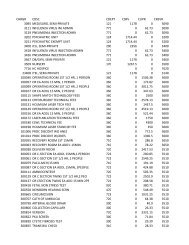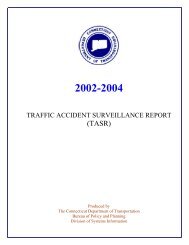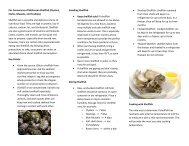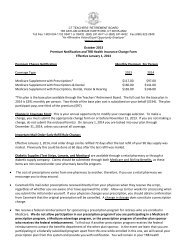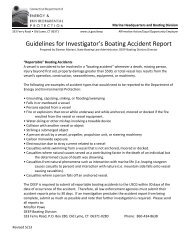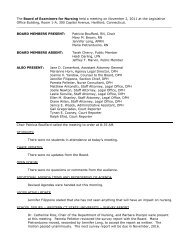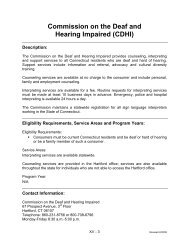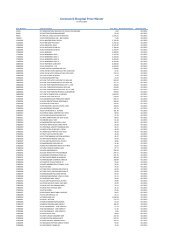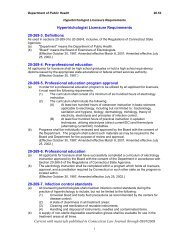Public Act 490 Guide - CT.gov
Public Act 490 Guide - CT.gov
Public Act 490 Guide - CT.gov
You also want an ePaper? Increase the reach of your titles
YUMPU automatically turns print PDFs into web optimized ePapers that Google loves.
PROPERTY REVALUATION AND PA <strong>490</strong><br />
PA<br />
<strong>490</strong><br />
SE<strong>CT</strong>ION 10: PROPERTY REVALUATION AND PA<strong>490</strong><br />
Revaluation is the process of determining what the<br />
fair market value is for all properties in a municipality.<br />
Municipalities are required to conduct a revaluation of all<br />
real property every five years in accordance with CGS<br />
Section 12-62(b)(1). This requirement and the process it<br />
entails sometimes results in confusion and raises many<br />
questions on the part of PA <strong>490</strong> landowners.<br />
The revaluation process is not a review of your PA <strong>490</strong><br />
status. Most often the revaluation process is conducted<br />
by consultants hired by a town for the purpose of the<br />
revaluation. All property is treated the same during this<br />
process. Adjustments are made later by the town depending<br />
upon what special conditions apply to a given property<br />
including the reduced assessment of PA <strong>490</strong>.<br />
As an owner of real property, the PA <strong>490</strong> property<br />
owner will receive notice of the revaluation for that property.<br />
That notice will reflect the assessment (which is 70%<br />
of the fair market value) for the property and not your<br />
PA <strong>490</strong> value. Some assessors may enclose a second<br />
notice for owners of PA <strong>490</strong> land showing the assessment<br />
after applying PA <strong>490</strong> values; others do not. Keep in mind<br />
that state law requires owners of all real estate to be<br />
notified of the 70 percent full market value of their property<br />
regardless of its classification under PA <strong>490</strong>. A landowner<br />
should read notices carefully. If the landowner is<br />
unclear as to whether or not the property assessment is<br />
reflective of market or PA <strong>490</strong> value, it is recommended<br />
that they contact the assessor in the municipality where<br />
the land is located and ask which classification it reflects.<br />
The values for various categories and subcategories<br />
for PA <strong>490</strong> classifications are required to be updated<br />
every five years by the Office of Policy Management (CGS<br />
Section 12-2b), in consultation with the Department of<br />
Agriculture (PA 94-201).<br />
Accordingly, a PA <strong>490</strong> property owner should expect<br />
that the assessment on their PA <strong>490</strong> land may change every<br />
five years. Such PA <strong>490</strong> adjustments may or may not<br />
coincide with a town’s overall revaluation of real property.<br />
In a year of revaluation, an assessor may send<br />
out a questionnaire to owners of land classified as<br />
PA <strong>490</strong> farmland in order to update town records.<br />
This is to verify that the land is still being actively<br />
farmed either by the owner/farmer or by a lease<br />
farmer. This is also a way for the assessor to assure<br />
that the farmland is categorized properly and to<br />
assure fairness and equity in the process. It is not<br />
necessary nor appropriate for a landowner to fill out<br />
a new application for PA <strong>490</strong> farmland, but rather to<br />
merely revise as necessary the information in the<br />
original application. It is important that the owner<br />
of PA <strong>490</strong> farmland respond to the assessor when<br />
this information is requested and to make copies of<br />
all submitted documents.<br />
The PA <strong>490</strong> values determined by the Connecticut<br />
Office of Policy and Management and the Department of<br />
Agriculture are recommended values generated to assist<br />
towns in assigning a value to PA <strong>490</strong> properties. In doing<br />
this, the Department of Agriculture has broken down<br />
each category into various subcategories. For farmland<br />
there are eight subcategories and for forest land there is<br />
one. If a property owner or assessor is in doubt as to what<br />
the proper subcategory should be, a consultation with<br />
the Department of Agriculture, Connecticut Farm Bureau,<br />
the Connecticut Department of Environmental Protection<br />
Division of Forestry, the local agricultural extension offices,<br />
or the Soil and Water Conservation District will be helpful<br />
in determining the proper designation.<br />
24<br />
<strong>Public</strong> <strong>Act</strong> <strong>490</strong>: A Practical <strong>Guide</strong> and Overview • http://www.cfba.org/pa<strong>490</strong>guide.htm • Connecticut Farm Bureau Association




